Although the electric car has only been on the rise for a few years now - as it were - man began its development as early as the 19th century. In fact, the first electric "car" dates back to 1839. I say "car" because it was in fact a carriage equipped with an electric motor powered by a non-rechargeable energy battery; it reached 6 km/h. The architect of this vehicle was Robert Anderson.
To see the first rechargeable batteries, it was necessary to go back to 1880, when they began to be mass-produced. In 1899, the electric vehicle "La Jamais Contente" set a speed record, reaching 105.3 km/h in the hands of the Belgian driver Camille Jenatzy. From that moment on, electric cars overtook other means of transport, accounting for 30% of all cars in the USA in 1900. However, everything changed in 1911, when the first starter motor for gasoline cars appeared and these began to be mass-produced, thus increasing their performance, comfort and ease of use. Until then, cars had to be started by hand crank, with all the discomfort and danger that this entailed.

Nowadays, the situation has been reversed and the electric car is coming with force, ready to stay and to condemn the internal combustion engines. Oil is more expensive than electricity, increasingly scarce and less efficient. The increase in pollution rates and air quality problems in our cities is proving problematic. In addition, electric power has improved in terms of its distribution and generation from carbon-free (renewable) sources or nuclear waste.
The Lohner-Porsche Semper Vivus initiated the 20th century.
As I have just mentioned, electric cars were in full swing from 1900 onwards. At the Paris World's Fair of the same year, the company k.u.k. Hofwagenfabrik Ludwig Lohner & Co. presented the Lohner-Porsche Semper Vivus ("always alive" in Latin), the product of the work of chief designer Ferdinand Porsche, who was only 25 years old at the time. Porsche's genius lay in the placement of two engines in the front wheel hubcaps, which he had developed four years earlier.
They operated without gears or drive shafts because the wheel, like the rotor of the DC motor, rotated in the direction of the shaft, mounted in the direction of travel of the wheels. It had no friction losses and achieved an efficiency of 83% with a quiet and smooth behaviour. The motors were housed in the two wooden spoked wheels and each weighed 115 kilos. Under normal conditions, each motor generated 2.5 hp at 120 RPM, achieving a continuous top speed of 37 km/h (23 mph). It was even possible to reach 50 km/h with a power of 14 hp, but only for a duration of about 20 minutes. The heavy battery weighed 410 kilos and consisted of 44 batteries. Its 300 amperes and 80 volts offered an energy capacity of 24 kWh, enough to reach 50 km/h.
It is worth mentioning that, as is typical of Porsche's philosophy (before it was a manufacturer as such), there was a racing version of this car, specifically created for the British E.W Hart. It had two more electric motors on the rear axle (the first car with all-wheel drive), resulting in a 1,800-kilogram vehicle capable of reaching 60 km/h (37 mph).
The organisers of the world exhibition awarded a prize to the Lohner-Porsche, and an automobile magazine wrote: "The epoch-making innovation is based on the elimination of all intermediate gears, such as toothed belts, chains, differentials, etc. In short, it is the first free-wheel drive car in history".
300 of these units were manufactured at a price of between 10,000 and 35,000 Austrian crowns, the equivalent today of a six-figure sum. It was aimed at people with high purchasing power and was so easy to drive that the motoring press said it had "no tendency to skid on sharp bends or smooth stones or muddy ground, and it was as if it were horse-drawn, so that the drag was hardly annoying".
Although it is credited with being the first hybrid in history, that's not entirely true, but it's not wrong either. As early as 1896, the British H. J. Dowsing and L. Epstein patented ideas on parallel hybridization that were later used in the United States to move large vehicles, such as trucks or buses. In 1898, Emilio de la Cuadra founded the Compañía General Española de Coches Automóviles E. de la Cuadra Sociedad en Comandita (a short name if ever there was one) to manufacture electric vehicles together with the Swiss Carlos Vellino and Marc Charles Birkigt Anen. Optionally, they could have a gasoline engine coupled with a generator that was responsible for recharging the batteries constantly (series hybrid), but the electric accumulators gave problems in its presentation to the public and was unsuccessful. The Belgian brothers Henri Pieper and Nicolas Pieper built their Voiturette in 1899, with a petrol engine connected to an electric one under the seat.
It was not until 1901 that Porsche developed its hybrid car. Designed as a series hybrid, it generated electricity with a generator under the front seats and was equipped with a 16 hp four-cylinder Daimler engine. The vehicle weighed only 930 kilograms and achieved a top speed of 80 km/h. Why is it not wrong to consider it the first hybrid in history? Because despite the fact that this technology had already been launched on the market a year earlier, this car was the world's first production hybrid.
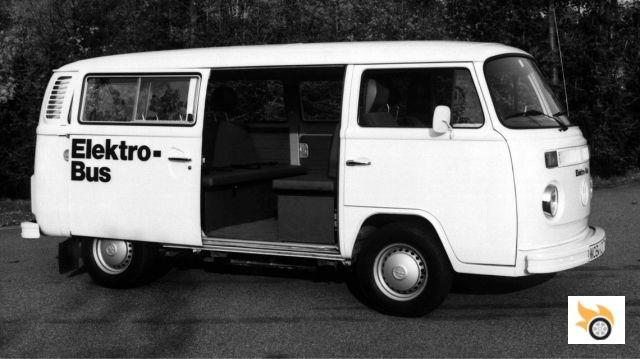
After decades of oblivion, we go back to the experimental 70s.
Volkswagen as a manufacturer had been established in the 1930s under the design of the Third Reich and with an important collaboration with Ferdinand Porsche. It wasn't until after the war that this manufacturer started to test electric cars, as electric cars had quickly fallen into oblivion since the 1920s. To see the first electric model with Volkswagen badge we have to jump back in time to 1973, with the second series Transporter (T2). To develop the electric van, Volkswagen engineers worked closely with Bosch, Varta and Germany's largest electric company, Rheinisch-Westfälische Elektrizitätswerk (RWE).
One of the first versions of this model was the so-called "City Taxi", with parallel hybrid propulsion (not electric as in the rest). In purely electric mode, the T2 could travel up to 40 km with a top speed of 70 km/h. It was tested over 12,875 km and was exhibited at various shows such as the Museum of Modern Art in New York.
In the other versions without a combustion engine, the electric motor was located at the rear of the vehicle and generated 23 hp of continuous power, with a peak of 45 hp and a maximum torque of 160 Nm. Power was transmitted to the rear axle via a single-stage transmission and it accelerated from 0 to 50 km/h in 12 seconds, making it achieve a top speed of 75 km/h. The huge battery in the load floor stored 23.8 kWh of energy, which was enough to achieve a range of 50 to 80 kilometres. The battery weighed 850 kilograms, which meant that the Transporter - reinforced chassis in between - weighed 2.2 tons. Only 70 units were built at a starting price of 42,595 Deutschmarks at the time.
Between 1979 and 1984, 50 electric units of the T3 model were produced in Wolfsburg, to which 12 more were added in 1980 for testing by the German postal company.
The year is 1976. Volkswagen wanted a compact, economical and eco-friendly car. At that time, the brand's researchers decided it was a good idea to take a Golf, remove the combustion engine and replace it with an electric one. The engine generated about 25 hp and covered about 20,000 kilometers until 1986, serving as a test base for various batteries and electric motors. Its top speed was 80 km/h (50 mph) and it had a range of 70 km (43 miles). This was the Elektro-Golf I.
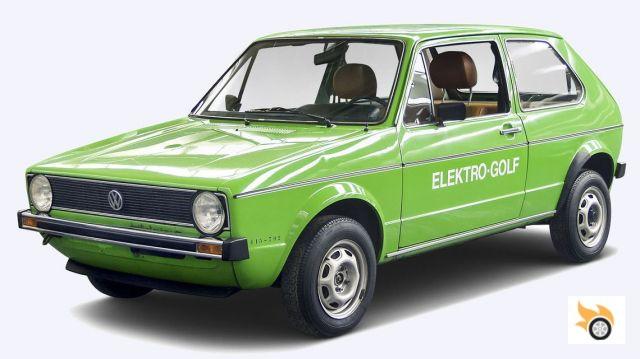
The Citistromer saga, the genesis of the electric Golf
But without a doubt, the best known electric car of the German firm was the Golf CityStromer, based on the Golf I, II and III. The first models came to life as experimental models that were later sold as second-hand units to private individuals. The third box Golf CityStromers were sold directly to the customer, although almost all of them went to companies at first. Many are still in private hands today.
They tested the model so well before selling it to the general public that, since the idea began in 1976, it wasn't until 1989 when the first electric Golf made its debut, with 70 units built. In 1993, taking advantage of the arrival of a new Golf and a cooperation agreement with Siemens, the second generation of the CityStromer was presented. According to the brand, around 120 examples were sold up to 1996.
If it is already rare to find a CityStromer, it is even rarer to find one with the steering wheel on the right. Of those 100 examples built on the Mk. II chassis, only two were made with right-hand drive. A woman found one of these two units in 2009, although not in its best condition, as it needed a restoration having lost much of its powertrain. Given the high price of repairs, the woman decided to sell her car in December 2010, but not to just anyone, but to Volkswagen UK itself. Coincidentally, the company was looking for a right-hand drive Golf CityStromer. As sad as it was for the woman to part with her little electric car, Volkswagen paid her what it cost her.
Let's recap. The first really serious steps began in 1981, again through collaboration with RWE. Instead of making use of high-voltage motors, Volkswagen decided to use a pack of 16 96-volt gel batteries that gave the 11.4 kilowatt electric motor a range of 60 kilometers and a top speed of no more than 100 km/h (62 mph). Only 25 units were built and were used by Volkswagen itself and the electric company RWE.
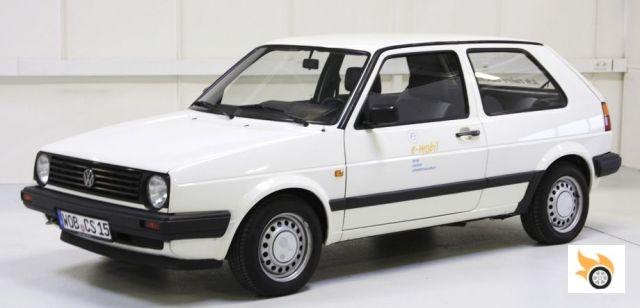
In 1985 a CityStromer was presented on the "box two" of the Golf. The technology was the same as that used for the 1981 model, although duly revised and adapted. For the third generation, the final power output remained at a modest 24 hp, with a peak of 30 hp, offering a range of 90 km and a top speed of 100 km/h. Although these figures vary a little. In practice, the CityStromer "III" was 480 kg heavier than a standard Golf due to the 17.3 kWh lead-acid batteries, and the actual range was 70 km in summer and 40 km in winter. The 0 to 100 km/h could take about 27 seconds, that's if it managed to reach that figure. 0 to 50 km/h was "only" 13 seconds...
The battery could be charged at any 220 volt socket and be charged to 80% in about one and a half hours. The Elektro-Golf I needed about 12 hours to fully charge its batteries.
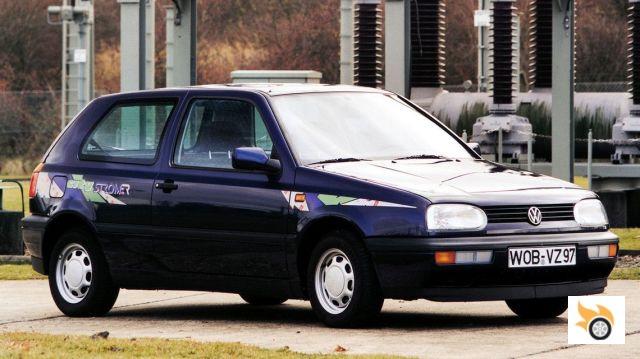
The exterior differences between a CityStromer and the mundane diesel or petrol-powered Golfs were almost negligible. Just some vinyl, the nameplate and the fact of not having exhaust, in addition to the speedometer set to much lower peaks. A particularity of this model is that it did not have a direct-ratio transmission, like almost all electric vehicles today, but had a four-speed manual transmission. In addition, it had innovative technologies for the time, such as an energy recovery system that came into action when braking, i.e. the electric motor itself generates energy when holding.
Towards the end of the 1980s, the Jetta CityStromer appeared as a test vehicle using a new type of sodium sulphide battery that offered a range of 120 km. The 276-kilogram battery was housed in a specially modified tunnel with a complex cooling and heating system used to keep the battery between 300 and 350 degrees Celsius. The electric motor generated 25 hp, enough to reach a top speed of 105 km/h and take 12 seconds to go from 0 to 50 km/h. Later, electric versions of the Golf IV and Bora were produced.
The first electric-hybrid Golf was produced in 1987, and in 1991 Volkswagen launched a fleet of 20 units in Zurich. The electric motor could generate 9 hp, and when the car's speed reached 60 km/h, the 60 hp 1.6 turbodiesel engine kicked in. Different types of lead-acid, nickel-cadmium and sodium sulphide batteries were used, the most powerful version of which stored 8 kWh. The test vehicles consumed 2.5 liters of diesel and 16.4 kWh of electricity per 100 km - good fuel consumption even for a modern car.
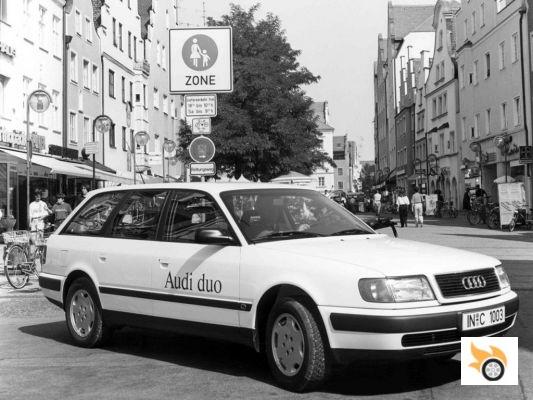
At the same time, engineers were working intensively on new battery technologies. The German Automobile Association (DAUG), a subsidiary of Volkswagen and Daimler-Benz, developed a nickel-based battery together with Varta. Volkswagen's interest in all this is shown in the hybrid prototype based on the 1990 Sharan, in which the four-cylinder petrol engine was supplemented via a flywheel by an electric motor and a continuously variable transmission.
Before that prototype, in 1989, Audi presented the first generation of Audi duo, a technical concept based on the Audi 100 Avant. It featured a 136 hp five-cylinder gasoline engine driving the front wheels and a 12 hp electric motor working on the rear wheels in a sort of reinterpretation of quattro all-wheel drive. The nickel-cadmium batteries had a capacity of 8 kWh and could maintain electric mode for 25 km.
Two years later, on the same basis, a second generation of the duo was presented. The five-cylinder engine was replaced by a four-cylinder engine and the batteries became sodium sulphide. The electric input was 29 hp and the range was 80 km. Another change was the way of delivering power to the wheels: the combustion engine also helped push the rear wheels.
In 1997 Audi brought out a third version of its duo. It was based on the A4 Avant and featured the 90 hp 1.9 TDI and a 29 hp water-cooled electric motor with a maximum peak of 48 hp. Both engines worked on the front axle and the lead-gel battery, located in the rear, could store 10 kWh.
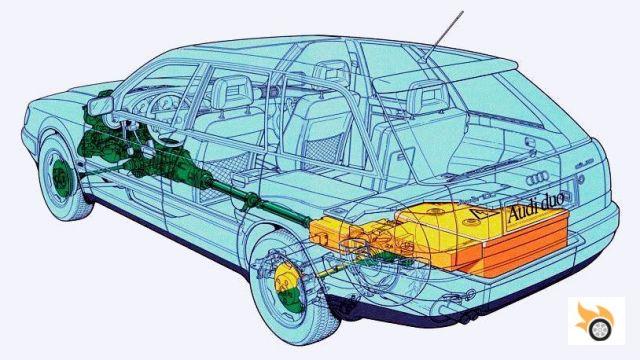
As with the previous prototypes, the standard duo also followed a pioneering concept. Its battery could be recharged from a household socket and, in addition, the electric motor functioned as a generator during diesel propulsion and deceleration and regenerated the battery. In electric mode, the duo achieved a top speed of 80 km / h, which, with the TDI engine, reached 170. Similarly to Volkswagen's electric Transporter, the Audi hybrid focused on commercial customers, for whom a leasing program was defined. It was priced at 60,000 Deutschmarks at the time.
In 1997 also came to market a hybrid that would change the perception of them to this day, the Toyota Prius 1G. Of course, it was not until 2000 that we would see it on the roads of the rest of the world, because until then it was only available for the Japanese market. The Audi duo had nothing to do against the Prius, was a much more expensive model than the Audi A4 Avant TDI from which it started, the difference in fuel economy was negligible and only 100 units were produced. We can not say that the duo was a success, unlike the Prius.
Returning to Volkswagen as a brand, the early nineties brought new developments in the field of hybridization, especially in smaller vehicles. In 1991 the Volkswagen Chico was introduced, a 3.2-metre-long city car with a 34 hp 0.6-litre twin-cylinder petrol engine and a 9 hp electric motor. With this, the three units that were produced managed to reach 131 km / h with a combined fuel consumption of 1.4 liters and 13 kWh per 100 km. In 2001, one hundred years after the Lohner-Porsche, Volkswagen took up the idea of wheel-mounted engines in a test Lupo. The total output was 120 hp and a torque of 2,000 Nm. Weighing 1,370 kg, it accelerated from 0-100 km/h in 10.5 seconds.
In 2008 in Geneva we met the Golf TDI Hybrid Concept, a vehicle that combined the three-cylinder combustion engine 1.2 TDI 75 hp and a small electric motor of 27 hp. It was equipped with a seven-speed DSG transmission and promised a fuel consumption of 3.4 liters per 100 kilometers with emissions of less than 90 g/km of CO2. It was designed to run either in pure electric mode (in the city), or to run with just the turbodiesel engine or with both connected. Unfortunately, this car remained just that, a concept. To be able to couple the electric motor to the three-cylinder diesel engine would have required a complete redesign, which would have cost too much.
We had to wait until 2010 to see a new all-electric "people's car", the Golf VI Blue-E-Motion. This model featured 26.5 kWh lithium-ion batteries, which allowed the car to accelerate from 0 to 100 km/h in 11.8 seconds and reach 140 km/h. The range was 150 km, thanks in part to solar panels on the roof that collected additional energy to cool the batteries and improve their performance.
From there, we are already in the present. In 2013, the E-Golf was introduced, based on the seventh generation of the successful compact car. In the same year, the E-Golf had an approved range of 190 km with 24.2 kWh lithium-ion batteries. It produced the equivalent of 115 hp, allowing it to achieve more than decent performance with a sprint to 100 km/h in 10.4 seconds and a top speed of 140 km/h. For the 2017 version, the batteries were increased in size by 48%, with 35.8 kWh and a power output of 136 hp. The range is 300 km, the top speed is increased by 10 km/h and the 0 to 100 km/h decreases to 9.6 seconds.
It is clear that, as in the rest of the automotive industry, the future is based on electrification. The I.D. and I.D. Buzz prototypes anticipate the future of mobility in cars. The former intends to reach the market in 2020, with the possibility of being 100% autonomous by 2025. The reinterpretation of the T1 also intends to do the same.
In the past, electric cars have primarily been adaptations of conventional vehicles. For greater efficiency, Tesla's approach, a fully dedicated platform, optimizing space for batteries and taking advantage of gaps that are no longer needed for the mechanisms of a conventional car, must be used. Thus, when the electric car becomes a genre in itself, is when it is really interesting; just look at what has happened with the Tesla Model S, within its segment (E Premium).
The electric Volkswagen of the future will be based on a dedicated platform, the MEB. Then it will be possible to offer autonomies more in line with the expectations of customers -sometimes exaggerated-, a better distribution of interior space without the need to lengthen the exterior, more features ... and what is more interesting: a more contained price. To get to the current situation Volkswagen has not started from nothing, it has had decades of experience, even if they have been commercial anecdotes and tests in petit comité almost always in Germany. There is no future without the past.

























